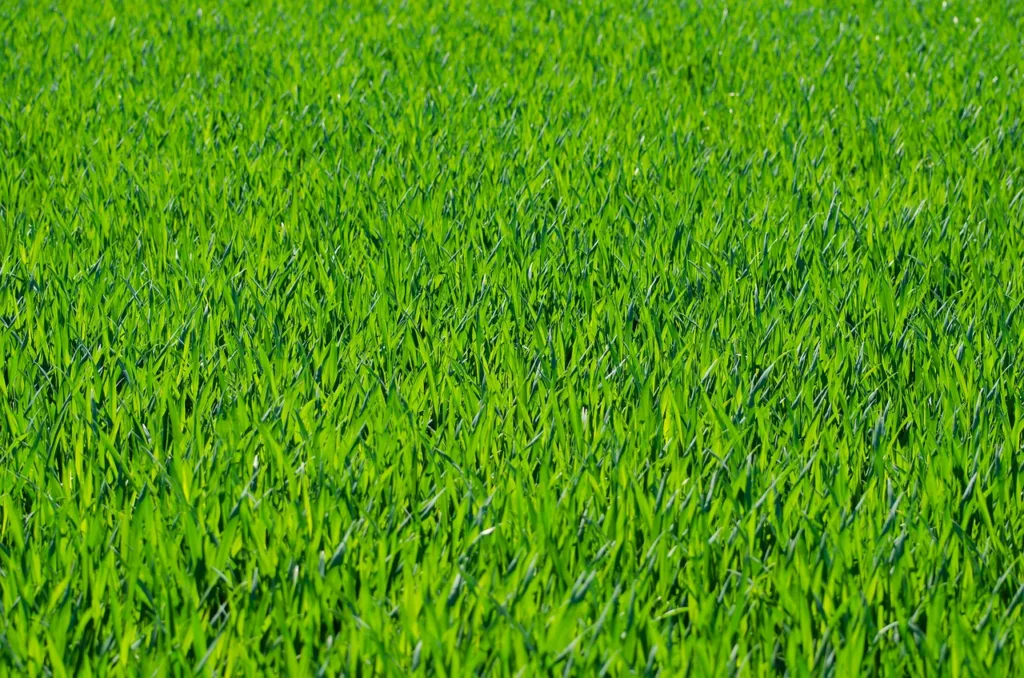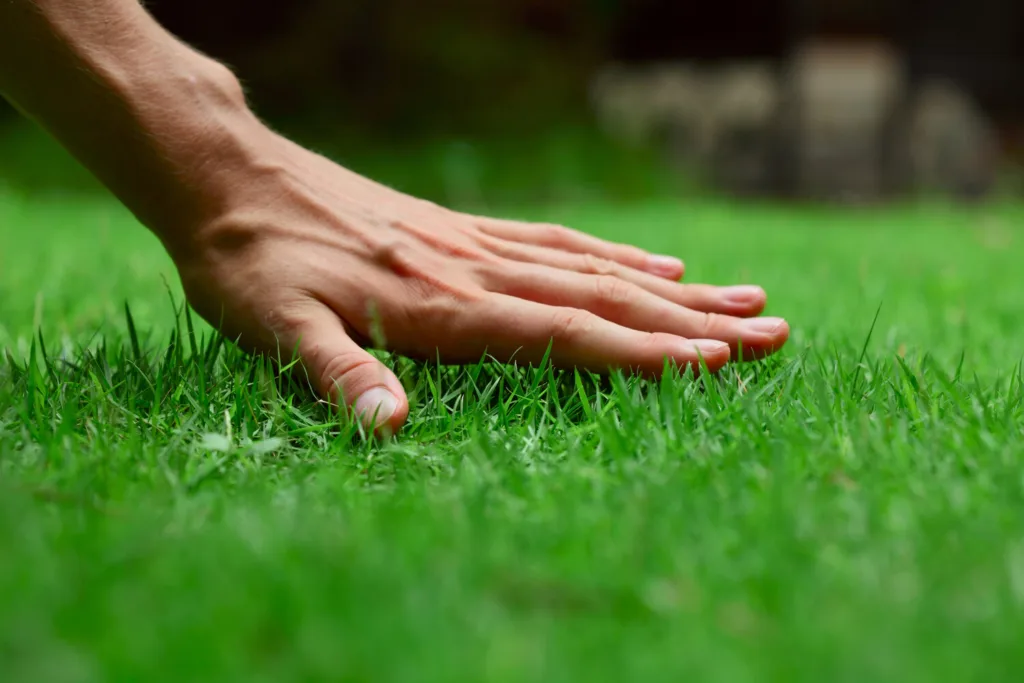St. Augustine grass, also known as Stenotaphrum secundatum, is a type of grass that grows well in hot climates. Also known as buffalo turf in Australia and buffalo grass in South Africa, is a type of grass that belongs to the Poaceae family.
Uses and Season
It is typically grown in tropical and subtropical regions and is a warm-season lawn grass. It is known for its thick, carpet-like appearance and lively green color. It is commonly used in lawns, parks, and golf courses in warm and humid climates.
St. Augustine grass is a warm-season grass that requires proper care and maintenance to flourish. This includes regular mowing, fertilizing, and watering. Although it grows best in full sunlight, some varieties can tolerate partial shade, providing flexibility in the landscape.
Many people have started using St. Augustine grass plugs, which are small sections of sod containing both grass and a root system, as an efficient method for establishing a healthy and beautiful lawn.
St. Augustine grass is an attractive and strong choice for creating a green haven in your outdoor space. If you have any specific questions or want to know more about St. Augustine grass, don’t hesitate to ask!
| Characteristic | Description |
|---|---|
| Scientific Name | Stenotaphrum secundatum |
| Common Names | St. Augustine Grass, Charleston Grass, Buffalo Turf, Carpet Grass |
| Family | Poaceae (Grass family) |
| Origin | Tropical regions, native to the Gulf of Mexico and the Mediterranean coast |
| Adaptation | Rapid growth, established quickly |
| Appearance | Broad, coarse-textured blades; dark green color |
| Height | Varies, usually 2 to 4 inches, can grow taller with adequate water and nutrients |
| Growth Rate | Rapid growth, establishes quickly |
| Sunlight | Thrives in full sun but tolerates partial shade |
| Soil Type | Well-drained, prefers slightly acidic to slightly alkaline soils |
| Drought Tolerance | Rapid growth, established quickly |
| Cold Tolerance | Limited cold tolerance, susceptible to winter damage in cooler climates |
| Disease Resistance | Moderate drought tolerance may go dormant during extended dry periods |
| Maintenance | Moderate maintenance, benefits from regular fertilization and watering |
| Watering | Regular watering is essential; prefers consistent moisture |
| Mowing Height | Typically mowed at 2.5 to 4 inches |
| Uses | Residential lawns, commercial landscapes, parks, golf course roughs |
| Winter Dormancy | Can turn brown and go dormant in winter in colder climates |
| Seeding or Sodding | Typically established by sodding or plugs, as seed availability is limited |
| Invasive Potential | Moderately invasive, forms a dense turf |
| Resilience | Vulnerable to certain diseases, such as brown patches and gray leaf spot |
| Common Issues | Susceptible to chinch bugs, sod webworms, and certain fungal diseases |
| Fertilization | Regular fertilization with a balanced formula, especially in sandy soils |
| Cultural Tips | Avoid excessive nitrogen in fertilization; monitor for pest and disease issues |
Right Type of St. Augustine Grass
When it comes to St. Augustine grass, there are a few different varieties to consider. Each has its unique characteristics, and choosing the right one for your specific needs is crucial. Here are some common types of St. Augustine grass:
Floratam
This variety is known for its excellent heat tolerance and resistance to pests and diseases. It thrives in full sun but doesn’t do well in shaded areas.
Palmetto
Palmetto is a shade-tolerant variety that adapts well to a variety of soil types. It maintains its vibrant green color even in areas that receive limited sunlight.
Seville
If you’re looking for a low-maintenance option, Seville is an excellent choice. It requires less water and fertilizer than other varieties, making it a popular option for those with busy schedules.
Bitterblue
Bitterblue is a more cold-tolerant variety, making it suitable for regions with milder winters. It has a finer texture compared to other St. Augustine grass types.

Preparing Your Soil for St. Augustine Grass
Before you start planting St. Augustine grass, it’s essential to prepare the soil properly. This will provide an ideal environment for the grass to take root and thrive. Here’s how to do it:
Remove any existing vegetation: Clear the area where you plan to plant the grass by removing any weeds, rocks, or debris. This will prevent competition for nutrients and ensure optimal growth.
Test your soil: Conduct a soil test to determine its pH level and nutrient content. St. Augustine grass thrives in slightly acidic to neutral soil with a pH range of 6.0 to 7.5. Based on the soil test results, you may need to make amendments to adjust the pH or add nutrients.
Loosen the soil: Use a garden tiller or a shovel to loosen the soil to a depth of about 4 to 6 inches. This will facilitate root penetration and improve drainage.
Add organic matter: Incorporate organic matter like compost or well-rotted manure into the soil. This will enhance soil fertility and improve its ability to retain moisture.
Planting St. Augustine Grass
With the soil prepared, it’s time to dive into the planting process. Follow these steps to ensure the successful establishment of your St. Augustine grass seed:
Choose the right time: The ideal time to plant St. Augustine grass seed is during the late spring or early summer when the soil is warm. This allows the grass seeds to establish their root system before facing colder temperatures.
Purchase healthy sod or plugs: St. Augustine grass seeds can be planted using either sod or plugs. If you opt for sod, make sure it is healthy, weed-free, and well-maintained. For plugs, choose vigorous, disease-free plants.
Measure and mark the area: Calculate the square footage of the area where you want to plant St. Augustine grass seeds and mark out the section with stakes and string. This will help you ensure even coverage.
Lay the sod or plant plugs: If using sod, begin by laying the first piece along a straight edge and continue in a brick-like pattern. Press the sod firmly into the soil, eliminating air pockets. If planting plugs, space them out evenly, following the recommended spacing for the specific variety.
Water thoroughly: After planting St. Augustine grass seeds, water the sod or plugs deeply but gently. This will help settle the soil and ensure good root-to-soil contact. Keep the soil consistently moist during the establishment phase.
Caring for St. Augustine Grass
Once your St. Augustine grass seeds are planted, maintenance and care are essential for their long-term health and beauty. Here are some key aspects to consider:
St Augustine Grass Watering:
Proper watering is crucial to the health of St. Augustine grass seeds, especially during the hot summer months. Follow these watering tips:
Water deeply: Provide the grass with one inch of water per week, either through rainfall or irrigation. Apply the water slowly to allow penetration into the soil.
Avoid frequent shallow watering: This can lead to weak root growth and make the grass susceptible to drought stress.
Water in the early morning: Watering in the early morning minimizes evaporation and allows the grass to dry before nightfall, reducing the risk of diseases.
St Augustine Grass Fertilizer:
St. Augustine grass requires regular fertilization to maintain its lush, green appearance. Here’s how to fertilize effectively:
Opt for slow-release fertilizers: Slow-release or controlled-release fertilizers provide a steady supply of nutrients over an extended period, reducing the risk of excessive growth or nutrient loss.
Follow recommended rates: Apply the fertilizer according to the manufacturer’s instructions, based on the specific needs of your St. Augustine grass variety.
Avoid over-fertilization: Excessive fertilizer application can lead to thatch buildup, scalping, and increased pest and disease susceptibility.

St Augustine Grass Mowing:
Proper mowing practices play a vital role in keeping your St. Augustine grass healthy and attractive. Follow these guidelines:
Set the mower to the appropriate height: For most St. Augustine grass varieties, a height of 2.5 to 4 inches is ideal.
Avoid scalping: Never remove more than one-third of the grass blade length in a single mowing session.
Keep the mower blades sharp: Dull blades can result in uneven cuts, making the grass more susceptible to diseases and pests.
Weed and Pest Control:
To keep your St. Augustine grass in pristine condition, controlling weeds and pests is crucial. Consider the following strategies:
Use pre-emergent herbicides: Apply pre-emergent herbicides in early spring to prevent the germination of grassy and broadleaf weeds. Follow the instructions carefully to avoid damage to the grass.
Spot-treat for weeds: If weeds do appear, spot-treat them with a selective herbicide. Be cautious not to spray the herbicide on the St. Augustine grass itself.
Keep an eye out for pests: Common pests of St. Augustine grass include chinch bugs, armyworms, and sod webworms. Take action at the first signs of infestation, using targeted insecticides if necessary.
Conclusion:
Planting and caring for St. Augustine grass can be a rewarding endeavor that transforms your lawn into a lush, inviting space.
By selecting the right variety, preparing the soil, and following proper maintenance practices, you can enjoy a vibrant green carpet of St. Augustine grass for years to come.
So, get started on your journey to a beautiful lawn and create a space that you, your family, and friends can enjoy!
Remember, whether you choose Floratam or Palmetto, regular watering, proper fertilization, and adequate pest control are the keys to maintaining the beauty and health of your St. Augustine grass.
With a little effort and care, you’ll be able to enjoy the vibrant, welcoming greenery that St. Augustine grass brings to your outdoor space. Happy planting and nurturing!
People Also Ask
- Is St. Augustine a good lawn grass?
- Yes, St. Augustine Grass is a popular choice for lawns in warm climates due to its lush appearance, rapid establishment, and tolerance of partial shade.
- Where is St. Augustine grass from?
- St. Augustine Grass is native to tropical regions and is particularly found along the Gulf of Mexico and the Mediterranean coast.
- How aggressive is St. Augustine grass?
- St. Augustine Grass can be moderately aggressive. It spreads through stolons, allowing it to cover bare areas quickly, but it may encroach upon neighboring plant beds or other grass types.
- What fungus kills St. Augustine grass?
- St. Augustine Grass is susceptible to various fungal diseases, including brown patches and gray leaf spots. These can cause damage to the grass, leading to brown patches and thinning.

